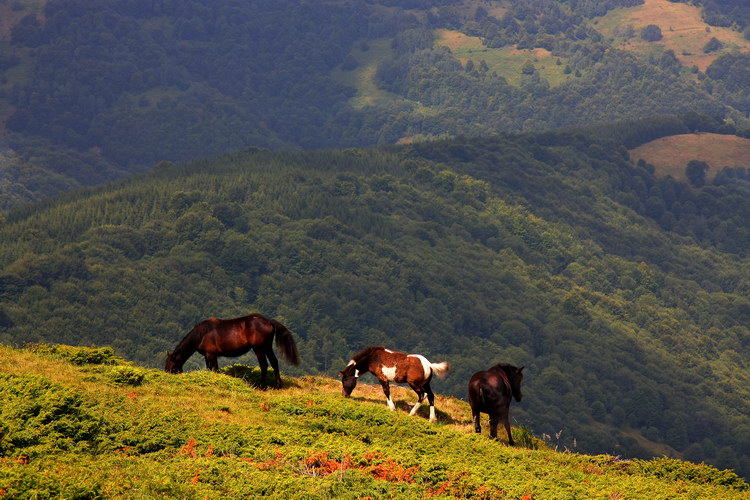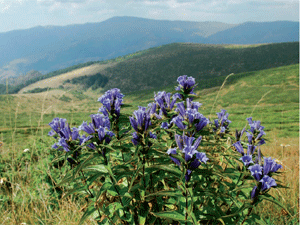The high mountain massif of Old Mountain is classified as a fold mountain. The main fold is about 550 km long, spreading from Zajecar to the Black Sea. Part of this range (150 km) is also a natural border between Serbia and Bulgaria; a large portion (approximately 400 km) divides Bulgaria into two parts: North and South. Old Mountain also has a different name-Balkan, and actually the Balkan Peninsula was named after this mountain. In the highest area of Old Mountain snow duration is 3-5 months in the winter. The thickness of snow cover in the Old Mountain is in a range of 0.30 to over 2.00 m., and the snow quality is very high in terms of status and viability of the upper surface of the snow with no icing, which is due to the position of the terrain in areas that are predominantly in the shades. Mean number of days with snow ranges from 90-180 days. Snow cover thickness of 30 cm lasts 70-140 days, and snow thickness of 50 cm or more (up to 2m) lasts for 40-100 days.
The highest peaks of the main cornice along the border between Serbia and Bulgaria are:
- Golemi kamen (1969m)
- Dupljak (2032m)
- Midzor (2169m)
- Golema cuka (1957m)
- Vrazja glava (1935m)
- Tri cuke (1937m)
- Kopren (1963m) i
- Srebrna glava (1932m)
A part of Old Mountain which is situated in Serbia belongs to the municipalities of Zajecar, Knjazevac, Pirot and Dimitrovgrad. The highest peak in Old Mountain is the Botev (2376m) and it is located in Bulgaria.
Separated from the main cornice is a branch that strives to Serbia. Major peaks of them are:
 Babin zub (1758m)
Babin zub (1758m)- Zarkova cuka (1848m)
- Prilepski vrh (1905m)
- Tupanar (1955m)
- Lazarevi jagraci (1874m)
- Bratkova strana(1943m)
- Mramor (1760m) itd...
The area of Old Mountain massif in Serbia is 1,802 square metres. Decision of the Government of the Republic of Serbia from 1997th is that the natural park Old Mountain which occupies 142 000 hectares is protected.
The entire drainage basin of the Old Mountain belongs to the Old Black Sea. In Serbia, all rivers from Old Mountain go to the Nisava and the Timok.
Targovishte’s Timok springs just below the Babin zub and Nisava springs below the top Kom (2016m) in Bulgaria. Other major rivers and streams are Toplodolska River, Visocica, Dojkinacka River Jelovicka and Rosomacka rivers. These rivers and streams merge in the following way: Rosomacka river flows into the Visocica, Jelovicka and Dojkinacka merge and then flows into Visocica, Toplodolska River and Visocica merge and make Temštica, which then flows into the Nisava. In its lower stream Visocica builds the lake Zavoj. The highest waterfalls in the Old Mountain are Cunguljski waterfall, 42m high, and waterfall Pilj which height in cascades is 64m.
There is a small number of transitions from one to the other side of the mountain that are used today. In Serbia that is just the Vrashka Cuke crossing, but long time ago people used the river bed at Vratarnice Sasko, Kadi-Bogaz near the village of Novo Korito and the old caravan crossing St. Nicholas, which connects the village of Ravno Bucije in the Republic of Serbia and Cuprene in the Republic of Bulgaria.

There are at least 1190 plant varieties on the territory of Old Mountain and it is a major habitat for tertiary and glacial endemic relict species. In particular we find: Winged Bellflower (Campanula calycialata), a local endemic species and Senecio pancici Deg., endemic species of the Central Balkans and they can only be seen on Old Mountain in Serbia. Then Blue Gentian (Gentiana alba) which is also very rare and now it could be only found at higher prominent limestone rocks. Also Blue-lutea species is protected by law. Among the interesting environments are the mountain peat bogs on Jabucko Ravnište, Babin Zub and around Arbinje .
Compared to the national flora in the Old Mountain 24.5% of plant species from the overall flora of Serbia grow there. Old Mountain is a significant center of tertiary relict and endemic plant species, which were kept in the gorges, and glacial relics and endemic in the high mountain areas.
Ecosystem diversity consists of 52 plant communities distributed in 10 classes, 18 lines and 26 bounds, of which there are 24 forest and shrubs and 28 herbaceous. Botanical significant areas of the Old Mountain are the highest mountain parts (Orlov kamen, Ravno bucje, Kadibogaz, Prevoj Sveta Nedelja, Midžor, Babin zub, Žarkova cuka,Vražja glava, Kopren, Tri cuke, Arbinje, Draganište, Bratkova strana).
Mountainous area where the specific forest communities are preserved (Golema Reka) gorges and canyons (Suvi do, Papratni do, kanjon Timocke reke, Topli do), highland area Golino.
Relict poly-dominant forest communities are developed at the Old Mountain, which build plant species of endemic and relict character; as a particularly valuable area so far the following reserves have been separated:
- Strict Nature Reserve Draganište which is included in the spruce forest ecosystem "Picetum excelsae serbicum" (Rudski 1949)., which builds a typical zone in the Old Mountain.
- Strict Nature Reserve Golema reka which includes indigenous forest community types of rainforest that provides a community of mountain beech "Luzulo-Fagetum serbicum, which is intended to preserve the genetic resources;
- Strict Nature Reserve Vražja glava which is an important site in the forest complex of the Old Mountain, where it is possible to follow the spontaneous development and the succession of plant species within it, especially maple (Acer heldreichii), as endemic of Balkan Peninsula. Rare plant species Pyrrole minor grow in these forests.
- Strict Nature Reserve Tri cuke is the most interesting because it includes a rare sub-alpine community of pine curve (Pinetum mughi) on the highest peaks and is the only site where the Curve Pine has been preserved.
- Strogi prirodni rezervat smrce Arbinje, is separated for the best preserved and most beautiful spruce forests in Old Mountain and in Serbia in general. With mono-dominant spruce forest community (Piceutm abietis montanum) there is a typical peat, sfagnum community with constant accumulation of peat with springs and streams, described as"Ass.Carici – Sphagno - Eriophoretum
- Strict Nature Reserve Kopren which is a site of Carnivorous plants of the family Drosera rotundifolia L.
















